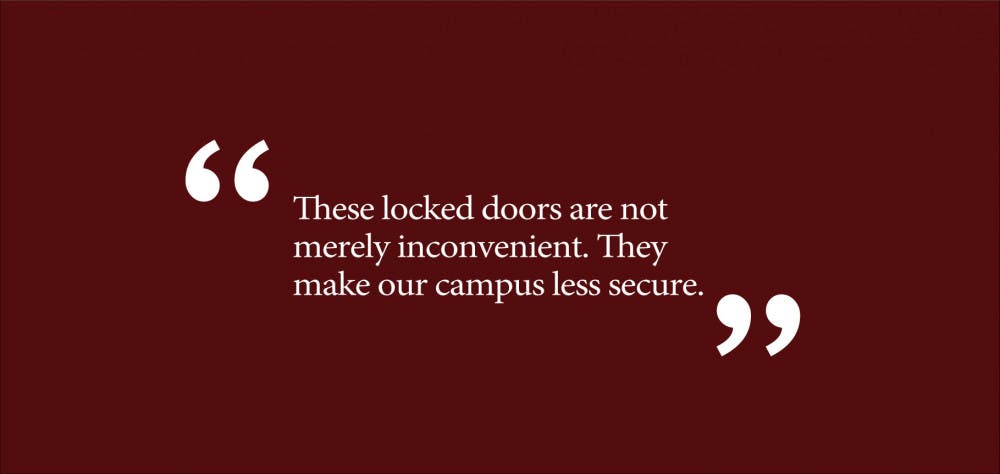How many times have you waited in the bitter cold for a friend to let you into their dorm? And of those times, how often did a kind stranger let you into the building, holding the door open as they swiped themselves in?
How many times have you walked up to Stephen Robert ’62 Hall (“New Watson”) after 8 p.m. and found the beautiful new study space inaccessible, with the door locked? Maybe you awkwardly knock on the glass wall, hoping someone will let you in. Or maybe you get lucky, and another student has propped the door open with a chair.
These locked doors are not merely inconvenient: They make our campus less secure. In order to make students’ lives easier and improve campus security, the University should expand student swipe card access to all dorms and academic buildings which are locked after hours.
The idea that locked doors can make us unsafe may seem counterintuitive. But the fact of the matter is that in my experience, if you wait long enough, it isn’t hard to get into most locked buildings on campus. Because I’ve been on the wrong side of a locked door many times, I always open the door for people who look like students, and other students will return the favor. In fact, despite the Department of Public Safety’s warnings, I don’t think anyone has ever declined to hold a locked door open for me. So locked doors have not prevented me from entering a building; they have simply slowed me down.
But if students were able to swipe into each others’ dorms and academic buildings, it is likely that students would no longer hold doors so liberally. If I saw someone waiting outside a dorm, I would no longer assume they were a student here, and I’d be significantly more hesitant to let them in.
Furthermore, increased swipe access could aid University security investigations. If a student does swipe into someone else’s dorm to break a rule or cause harm, the University would then have a record that they entered the building. By decreasing door-holding, increased swipe access would likely give the University a fuller picture of who entered the building.
Other schools have made expanded swipe access work. For example, Dartmouth allows students to access each other’s dorms from 8 a.m. to 9 p.m.. While this policy is unusual, it has strong support from the student body, as evidenced by the backlash when the school tried to take open access away. In the fall of 2019, Dartmouth’s administration restricted access to dorms as a safety measure in response to a series of racial bias incidents in October 2018, which included vandalism in dorms. But students pushed back immediately, arguing that restricting swipe access wouldn’t solve the safety problem. While Dartmouth’s Student Assembly had issued a request asking for increased security after the racial bias incidents, they rejected the dorm access change. In fact, Student Assembly President Luke Cuomo maintained that the policy could have unintended consequences that might reduce safety. According to the Dartmouth, 94 percent of students surveyed opposed the policy change. At a school where students are used to open access, the idea of locked doors didn’t make students feel more safe. Ultimately, student body pressure convinced Dartmouth to reverse course and restore universal access during daytime hours.
Brown should follow Dartmouth’s example. Expanded access does not mean students need 24/7 access to every building. But students should be able to swipe into their friends’ dorms during daytime hours and students should also have swipe access to popular study spaces, like the new Watson building.
At this school, known for its Open Curriculum, it’s time we have a more open campus as well.
Rebecca Aman ’20 can be reached at
rebecca_aman@brown.edu. Please send responses to this opinion to
letters@browndailyherald.com and op-eds to opinions@browndailyherald.com.



